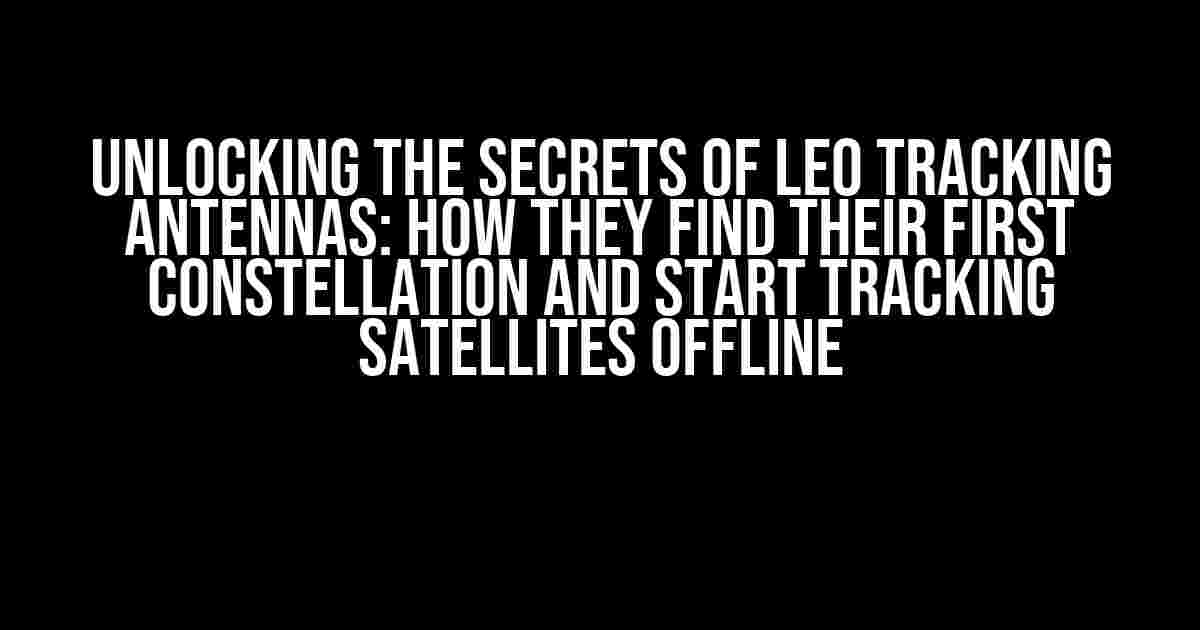Have you ever wondered how Low Earth Orbit (LEO) tracking antennas manage to find their first constellation and start tracking satellites even before they’re connected to the internet? It’s a fascinating process that involves a combination of technical wizardry and clever engineering. In this article, we’ll delve into the world of LEO tracking antennas and explore the magic behind their offline capabilities.
The Challenge of Satellite Tracking
Satellite tracking is a complex task, especially when dealing with LEO satellites that orbit the Earth at an altitude of around 160 km to 2,000 km. The satellites move rapidly, completing one orbit in approximately 90 minutes, which means that tracking antennas need to be incredibly agile and accurate to maintain a stable connection. Add to that the fact that there are numerous satellites in orbit, and you can imagine the complexity of the task at hand.
The Role of LEO Tracking Antennas
A LEO tracking antenna is specifically designed to track and communicate with LEO satellites. These antennas are equipped with advanced technology that enables them to detect and lock onto satellite signals, even in the absence of an internet connection. But how do they do it?
The Initial Search Phase
The process begins with the antenna’s initial search phase, during which it scans the sky for potential satellite signals. This is done using a combination of algorithms and electronic sensors that can detect the faint signals emitted by LEO satellites. The antenna is programmed to search for specific frequency bands and signal patterns that are unique to LEO satellites.
Doppler Shift and Frequency Offset
As the antenna searches for satellite signals, it needs to take into account the Doppler shift and frequency offset effects. The Doppler shift occurs when the satellite’s velocity causes a change in the frequency of the signal, while the frequency offset occurs due to the satellite’s distance from the antenna. The antenna’s algorithms must compensate for these effects to accurately detect and track the satellite signals.
Coarse Acquisition and Fine Tracking
Once the antenna detects a potential satellite signal, it enters the coarse acquisition phase. During this phase, the antenna uses a wide beamwidth to acquire a rough estimate of the satellite’s position and velocity. This information is then used to initiate the fine tracking phase, where the antenna refines its estimate of the satellite’s position and velocity using a narrower beamwidth.
How LEO Tracking Antennas Find Their First Constellation
So, how do LEO tracking antennas find their first constellation without an internet connection? The answer lies in their onboard ephemeris data.
Ephemeris Data
Ephemeris data is a set of predetermined orbital parameters that describe the position and velocity of satellites in orbit. This data is stored onboard the antenna and is used to predict the satellite’s position and velocity over time. The ephemeris data is typically updated periodically through a secure connection, ensuring that the antenna remains accurate and up-to-date.
Initial Position and Velocity Estimates
Using the ephemeris data, the antenna generates initial position and velocity estimates for the satellites in its field of view. These estimates are based on the satellite’s predicted orbit and the antenna’s own position and orientation. The antenna then uses these estimates to point its beam towards the predicted location of the satellite.
Starting to Track Satellites Offline
With the initial position and velocity estimates in place, the antenna can start tracking satellites offline. Here’s how:
Signal Detection and Verification
The antenna begins by detecting and verifying the satellite signal. This involves analyzing the signal’s frequency, modulation, and other characteristics to ensure it matches the expected satellite signal.
Locking Onto the Signal
Once the signal is verified, the antenna locks onto it using a process called signal tracking. This involves continuously monitoring the signal’s frequency and phase to maintain a stable connection.
Refining the Estimate
As the antenna continues to track the satellite, it refines its estimate of the satellite’s position and velocity using the signal’s Doppler shift and frequency offset. This ensures that the antenna remains accurately pointed at the satellite.
Conclusion
In conclusion, LEO tracking antennas are incredibly sophisticated systems that use a combination of algorithms, electronic sensors, and ephemeris data to find and track satellites even without an internet connection. By understanding the intricacies of the initial search phase, coarse acquisition, and fine tracking, we can appreciate the technical wizardry that goes into designing these remarkable systems.
Additional Resources
For those interested in learning more about LEO tracking antennas and satellite tracking, here are some additional resources:
- NASA’s Guide to Satellite Tracking: A comprehensive resource on satellite tracking and orbit determination.
- The European Space Agency’s (ESA) Satellite Tracking Handbook: A detailed guide to satellite tracking and navigation.
- The International Space University’s (ISU) Satellite Communications Course: A comprehensive online course covering satellite communications and tracking.
Code Snippet:
// Example C++ code for initial position and velocity estimates using ephemeris data
#include <iostream>
#include <cmath>
using namespace std;
struct Satellite {
double position[3]; // x, y, z coordinates
double velocity[3]; // vx, vy, vz coordinates
};
Satellite getInitialEstimates(EphemerisData ephemeris) {
Satellite satellite;
// Calculate initial position and velocity estimates using ephemeris data
satellite.position[0] = ephemeris.position_x + ephemeris.velocity_x * ephemeris.time;
satellite.position[1] = ephemeris.position_y + ephemeris.velocity_y * ephemeris.time;
satellite.position[2] = ephemeris.position_z + ephemeris.velocity_z * ephemeris.time;
satellite.velocity[0] = ephemeris.velocity_x;
satellite.velocity[1] = ephemeris.velocity_y;
satellite.velocity[2] = ephemeris.velocity_z;
return satellite;
}
| LEO Satellite Characteristics | Description |
|---|---|
| Orbit Altitude | 160 km to 2,000 km |
| Orbit Period | Approximately 90 minutes |
| Signal Frequency | VHF, UHF, and other frequency bands |
| Signal Modulation | Various modulation schemes (e.g., PSK, QPSK, etc.) |
Here are 5 Questions and Answers about “How do LEO tracking antennas find their first constellation and start tracking satellites, before they are connected to the internet?”
Frequently Asked Question
Curious about how LEO tracking antennas find their way to the satellites in the sky?
Q: How do LEO tracking antennas even know where to look for satellites in the first place?
A: LEO tracking antennas use a combination of built-in algorithms, GPS data, and celestial mechanics to predict the approximate location of the satellites. This information is often stored in the antenna’s firmware or memory, allowing it to start searching for satellites even without an internet connection!
Q: What happens if the antenna can’t find any satellites initially?
A: If the antenna can’t find any satellites, it will typically enter a “search mode” where it scans the sky in a methodical pattern, using its built-in algorithms to try and locate the satellites. This process can take a few minutes, but eventually, the antenna will lock onto the signal of the first visible satellite.
Q: How does the antenna know which satellite is which?
A: Once the antenna detects a satellite signal, it uses a technique called “signal fingerprinting” to identify the specific satellite. This involves analyzing the unique characteristics of the signal, such as its frequency, modulation, and Doppler shift, to determine which satellite is transmitting the signal.
Q: Can LEO tracking antennas work in areas with heavy interference or obstruction?
A: While LEO tracking antennas can operate in areas with some interference or obstruction, their performance may be degraded. To mitigate this, many modern antennas use advanced signal processing techniques, such as adaptive filtering and interference mitigation algorithms, to improve their ability to detect and track satellites in challenging environments.
Q: Do LEO tracking antennas need to be calibrated or configured before use?
A: Typically, LEO tracking antennas come pre-calibrated from the manufacturer, so they’re ready to use out of the box. However, some antennas may require occasional software updates or configuration adjustments to optimize their performance, especially in certain environmental conditions.


